CHAPTER
XI
THE
VARIOUS RELIGIOUS
ORDERS
The various
Orders existing in England
in pre-Reformation days may be classified under four headings (1)
Monks, (2)
Canons Regular, (3) Military Orders, and (4) Friars. As
regards the nuns, most of the houses were
affiliated to one or other of the above-named Orders.
I.
Monks
i. Benedictines
St. Benedict,
justly called the
Patriarch of Western Monachism, established his rule of life in Italy
; first at Subiaco and subsequently at Monte Cassino about A.D. 529. The design of his code
was,
like every other rule of regular life, to enable men to reach the
higher
Christian ideals by the helps afforded them in a well-regulated
monastery. According to the saint's original conception, the
houses were
to be separate families independent of each other. It was no part
of his
scheme o establish a corporation with branches in various localities
and
countries, or to found an "Order" in its modern sense. By its
own inherent excellence and because of the sound common-sense which
pervades
it, the Rule of St. Benedict at once began to take root in the
monasteries of
the West,
--- 213---
till it quickly
superseded any
others then in existence. Owing to its broad and elastic character, and
hardly
less, probably, to the fact that adopting it did not imply the joining
of any
stereotyped form of Order, monasteries could, and in fact did, embrace
this
code without entirely breaking with their past traditions. This,
side by
side in the same religious house, we find that the rule of St. Columba
was
observed with that of St. Benedict until the greater practical sense of
the
latter code superseded the more rigid legislation of the
former.
Within a comparatively short time from the death of St. Benedict in A.D. 543, the Benedictine became the
recognised
form of Western regular life. To this end the action of Pope St.
Gregory
the Great and his high approval of St. Benedict's Rule greatly
conduced.
In his opinion it manifested no common wisdom in its provisions, which
were
dictated by a marvellous insight into human nature and by a knowledge
of the
best possible conditions for attaining the end of all monastic life,
the
perfect love of God and of man. Whilst not in any way lax in its
provisions,
it did not prescribe an asceticism which could be practiced only by the
few ;
whist the most ample powers were given to the superior to adapt the
regulation
to all circumstance of time and places ; thus making it applicable to
every
form of the higher Christian life, from the secluded cloister to that
for which
St. Gregory specially used those trained under it : the evangelisation
of
far-distant countries.
The
connection between the Benedictines and England
began with the mission of St. Augustine
in A.D. 597. The Monastery
of Monte
Cassino having been destroyed by the Lombards,
toward
the end of the sixth century,
---214---
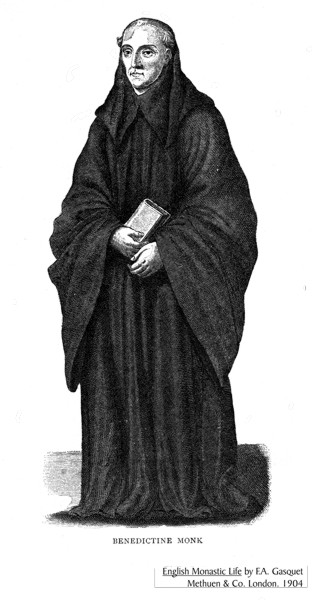
--215---
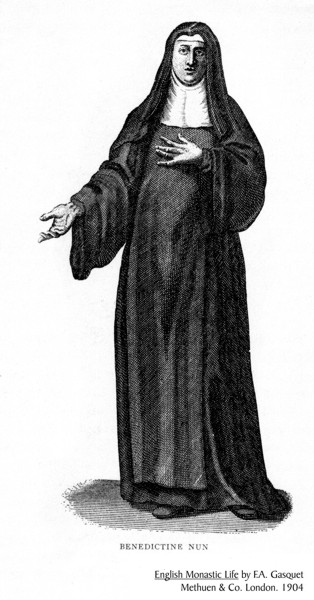
---216---
<>the monks took
refuge in Rome,
and were placed in the Lateran, and by St. Gregory in the church he
founded the
honour of St. Andrew, in his ancestral home on the Coelian Hill.
It was
the prior of St. Andrew's whom he sent to convert England.
With the advent of the Scottish monks from Iona
the
system of St. Columba was for a time introduced into the North of
England ; but
here, as in the rest of Europe, it quickly gave
place to
the Benedictine code ; and practically during the whole Saxon period
this was
the only form of monastic life in England.
ii. Cluniacs
The Cluniac
adaptation of the
Benedictine Rule took its rise in A.D. 912 with Berno, abbot of Gigny. With the assistance of the Duke of Aquitaine
he built and endowed a monastery at Cluny,
near Macon-sur-Saone. The Cluniac was a
new departure in monastic government. Hitherto the monastery was
practically
self-centered ; any connection with other religious houses was at most
voluntary, and any bond of union that may have existed, was of the most
loose
description. The ideals upon which Cluny
was established was the existence of a great central monastery with
dependencies spread over many lands, and forming a vast feudal
hierarchy of
subordinate establishments with the closest dependence on the
mother-house. Moreover, the superior of
each of the dependent monasteries, no matter how large and important,
was not
the elect of the community, but the nominee of the abbot of Cluny ; and in the same way the profession of every
member of the congregation was made in his home and with his sanction. It was a great ideals ; and
for two
---217---
centuries the
abbots of Cluny
form a dynasty worthy of so lofty a position. The
first Cluniac house founded in England
was that of Barnstable. This was speedily followed by that of Lewes,
a priory set up by William, earl of Warren,
in A.D. 1077, eleven years only after the Conquest.
The last was that of Stonesgate, in Essex,
made almost exactly a century later. On
account of their dependence upon the abbot of Cluny,
several of the lesser house were suppressed as “alien priories” towards
the
close of the fourteenth century, and those that remained gradually
freed
themselves from their obedience to the foreign superior.
At the time of the general suppression in the
sixteenth century there were thirty-two Cluniac houses ‘ one only,
Bermondsey,
was an abbey ; the rest were priories, of which the most important was
that
which had been nearly the first in order of time, Lewes.
iii.
Cistercians
The
congregation of Citeaux was
at one time the most flourishing of the offshoots of the great
Benedictine
body. The monastery of Citeaux was
established by St. Robert of Molesme in A.D. 1092.
The saint was a Benedictine, and felt himself
called to something different to what he had found in the monasteries
of France. The peculiar system of the Cistercians,
however, was the work of St. Stephen Harding, an Englishman, who at an
early
age had left his own country and never returned thither.
He struck out a new line, which was a still
further departure from the ideal of St. Benedict that was the Cluniac
system. The Cistercians, whilst strictly
maintaining the notion that each monastery was a family endowed with
the
principles of fecundity, formed themselves into an Order,
---218---
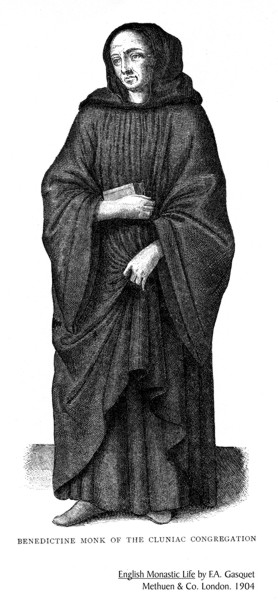
---219---
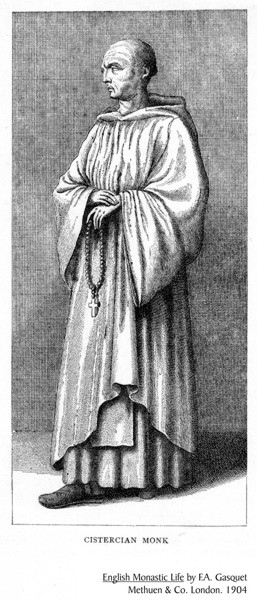
---220---
in the sense of
an organized
corporation, under the perpetual pre-eminence of the abbot and house of
Citeaux, and with yearly Chapters at which all superiors were bound to
attend. It was the chief object of the
administration to secure absolute uniformity in all things and
everywhere. This was obtained by the
Chapters, and by
their visitations of the abbot of Citeaux, made anywhere and everywhere
at
will. The Order spread during the first
century of its existence with great rapidity. It
is said that , by the middle of the twelfth century,
Citeaux had five
hundred dependencies, and that fifty years later there were more than
three
times that number. In England
the first abbey was founded by King Henry I, at Furness in A.D. 1127
and of the
hundred houses existing at the general suppression three-fourths had
been
founded in the twelfth century. The
rest, with the exception of St. Mary Grace, London,
established in 1349 by Edward III., were founded in the early part of
the
thirteenth century.
iv. Carthusians
The Carthusians were founded in the eleventh
century by St.
Bruno. With the help of the bishop of Grenoble
he built for himself and six companions, in the mountains near the
city, an
oratory and small separate cells in imitation of the ancient Lauras of
Egypt. This was in A.D. 1086 ; and the
Order takes its designation from the name of the place--Chartreuse. Peter the Venerable, the celebrated abbot of Cluny,
writing forty years after the foundation, thus describes their austere
form of
life. “Their dress,” he says, “is meaner
and poorer than that of other monks, so short and scanty and so rough
that the
very sight affrights one. They wear coarse
hair-shirts
---221---
next to their
skin ; fast almost
perpetually ; eat only bean-bread ; whether sick or well never touch
flesh ;
never buy fish, but eat it if given them as an alms ;
eat eggs on Sundays and Thursdays ; on
Tuesday and Saturdays their fare is pulse or herbs boiled ; on Mondays,
Wednesdays, and Fridays they take nothing but bread and water ; and
they have
only two meals a day, except within the octaves of Christmas, Easter,
Whitsuntide, Epiphany, and other festivals. Their
constant occupation is praying, reading and manual
labour, which
consists chiefly in transcribing books, They
say the lesser Hours of the Divine Office in their
cells at the
time when the bell rings, but meet together at Vespers and Matins with
wonderful recollection”
A
manner of life of such great austerity naturally did not attract many
votaries. It was a special vocation to
the few, and it was not until A.D. 1222 that the first house of the
Order was
established in England,
at Hinton, in Somersetshire, but William Langesper.
The last foundation was the celebrated
Charterhouse of Shene, in Surrey, made by King
Henry
V. At the time of the general
dissolution, there were in all eight English monasteries and about a
hundred
members.
II. The Canons Regular
The clergy of
every large church were in ancient times called canonici—canons—as
being on the list of those who were devoted to
the service of the Church. In the eighth
century, Chrodegand, bishop of Metz,
formed the clergy of his cathedral into a body, living in common under
a rule
and bound to the public recitation of the Divine
---222---
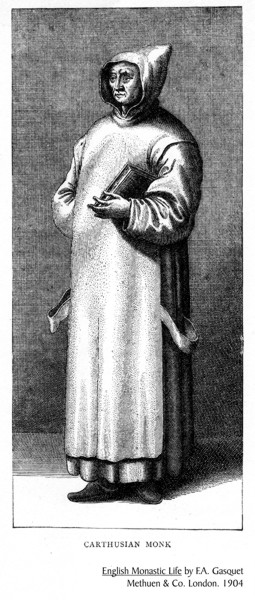
---223---
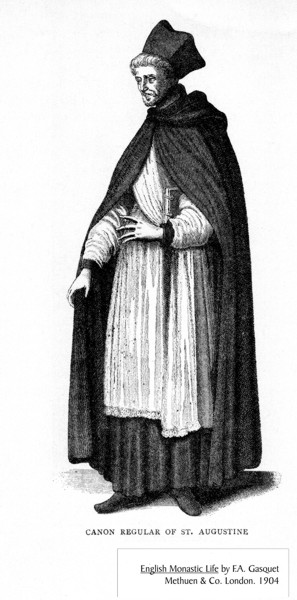
---224---
Office. They were known still as canons, or those
living under a rule of life like the monks, from the true meaning of
κανών, a
rule. The common life was in time
abandoned in spite of the provisions of several Councils, and then
institutions
other than Cathedral Chapters became organised upon lines similar to
those laid
down by Chrodegand, and they became known as Canons Regular. They formed themselves generally on the
so-called Rule of St. Augustine, and became known, in England
at least, as Augustinian Canons, Premonstratensian Canons, and
Gilbertine
Canons.
i. Augustinian Canons
The early
history of the Austin, or Black Canons, is involved in considerable
obscurity,
and it is only after the beginning of the twelfth century that these
Regulars
are to be found in Europe.
The Order was conventual, or monastic, rather
than congregational or provincial, like the Friars : that is, the
members were
professed for a special house and belonged by virtue of their vows to
it, and
not to the general body of their brethren in the country.
In one point they were not so closely bound
to their house as were the monks. The
Regular Canons were allowed in individual cases to serve the parishes
that were
impropriated to their houses ; the monks were always obliged to employ
secular
vicars in these cures. The Augustinians
were very popular in England
; most of their houses having been established in the thirteenth and
fourteenth
centuries. The earliest foundation was
that of Christ Church,
or Holy Trinity, Aldgate, made by Queen Maud in A.D. 1108 ; and at the
time of
the dissolution there were about 170 houses of Augustinian Canons
---225---
in England
; two of the abbeys, Waltham Cross and Cirencester, being governed by
mitered
abbots. In Ireland
they were even more popular and numerous, the number of the houses of
canons
being put at 223, together with 33 nunneries. The
Augustinian priors of Christ
Church, and All
Hallows, Dublin,
and seen other priors of the Order, had seats in the Irish Parliament. The habit of the Order was black, and hence
they were frequently known as Black Canons.
ii. The Premonstratensian Canons
This branch of
the Canons Regular was established by St. Norbert in A.D. 1119 at a
place
called Prémontré, a lonely and desolate valley near Laon
in France. Their founder gave them the Rule of St.
Augustine, and they became known either as Premonstratensians, from
their first
foundation, or Norbertines, from their founder. The
habit of these canons was white, with a white rochet
and even a
white cap, and for this reason they were frequently known as White
Canons. Besides following the ordinary
Augustinian
Rule, these Canons made Prémontré into a “mother-house,”
and the abbot of
Prémontré was abbot-general of the entire Order : having
the right to visit,
either by himself of deputy, every house of the congregation ; to
summon every
superior to the yearly General Chapter ; and to impose a tax for the
use of the
Order upon all the houses. This, so far
as England
is
concerned, lasted in theory until A.D. 1512, when all the English
houses were
placed under the abbot of Welbeck. Previously
they had been for more than thirty years supervised on behalf of the
abbot of
Prémontré, by Bishop Redman, who also continued to hold
the office of abbot
---226---
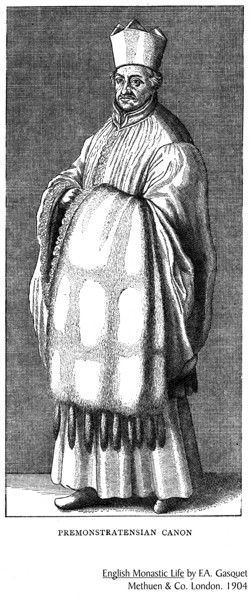
---227---
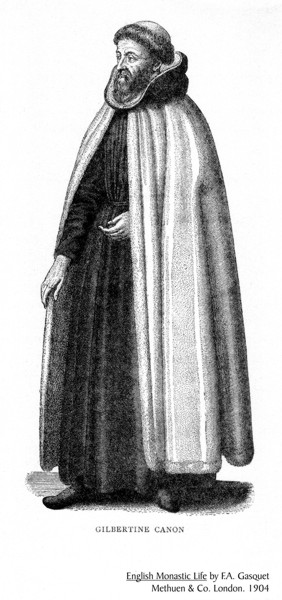
---228---
of Shap. In England,
just before the dissolution, there were some thirty-four houses of the
Order.
iii. The Gilbertines
The Canons of
St. Gilbert of Sempringham are said to have been established in A.D.
1139,
although the actual foundation as early as A.D. 1131, others as late as
A.D.
1148. St. Gilbert, the founder, was
Rector of Sempringham and composed his rule from those of St. Austin
and St.
Benedict. It was a dual Order, for both
men and women ; the former followed ST. Augustine’s
code with some additions, whilst the women took the Cistercian
recension of the
Benedictine Rule.
These canons,
according to Dugdale, had a black habit with a white cloak and a hood
lined
with lamb’s wool. The women were in
black with a white cap. In the double
monasteries the canons and nuns lived in separate houses having no
communication. AT first the Order
flourished greatly. St. Gilbert in his
lifetime founded thirteen houses, nine for men and women and four for
men
only. In these there are said to have
been seven hundred canons and fifteen hundred sisters.
The order was
under the rule of a general superior, called the master or
prior-general. His leave was necessary for
the admission of
members, and in fact, to initiate business or at least give validity to
the
proposals of any house. There were, in
all, some twenty-six of these establishments in England
at the time of the general dissolution. Four
only of these were considered as ranking
among the greater monasteries whose income was above £200 a year.
---229---
The
Military Orders
i. Knights Hospitallers of St. John of Jerusalem
The Hospitallers
began in A.D. 1092 with the building of a hospital for pilgrims at Jerusalem. The original idea of the work of these
visiting knights was to provide for the needs of pilgrims visiting the Holy
Land and to afford them protection on their way. They, too,
followed a rule of life founded upon that of St.
Augustine,
and their dress was black with a white cross upon it.
They came to England
very shortly after their foundation, and had a house built for them in London
in A.D. 1100. They rose in wealth and
importance in the country ; and their head, or grand prior as he was
called,
became the first lay baron in England,
and had a seat in the House of Peers.
Upon many of
their manors and estates the Knights Hospitallers had small
establishments name commanderies, which were under the
government of one of their number, called the commander.
These houses were sometimes known as preceptories,
but this was a term more
generally used for the establishments of the other great Military
Order, known
as the Templars. An offshoot of both
these orders was known as “The Order of St. Lazarus of Jerusalem.” There were a few houses of this branch in England,
which was founded chiefly to assist and support lepers and indigent
members of
the Military Orders. They are, however,
usually regarded as hospitals. The Knights
of St. John of Jerusalem had their headquarters at the Hospital
of St. John, near
Clerkenwell, to
which were attached some fifty-three cells or commanderies.
---230---
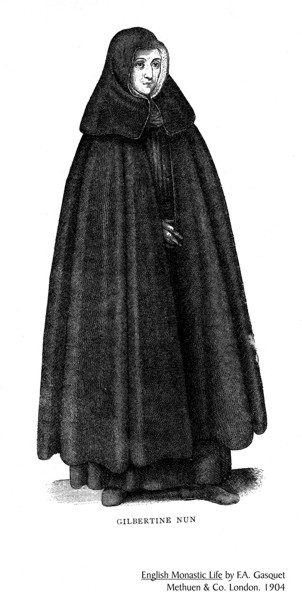
---231---
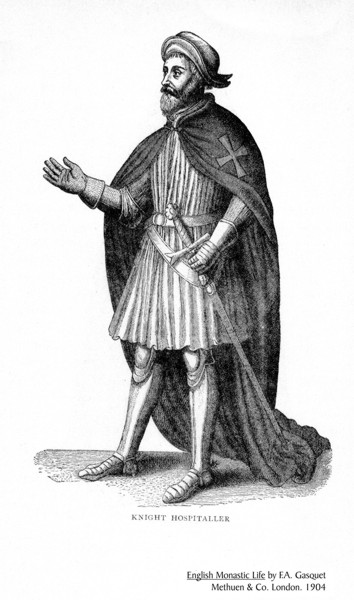
---232---
ii. The
Templars
The Military
Order of the Templars was founded, according to Tanner, about the year
A.D.
1118. They derived their name from the Temple
of Jerusalem, and the
original
purpose of their institute was to secure the roads to Palestine,
and protect the holy places. They must
have come into England
early in the reign of King Stephen, as they had several foundations at
this
time, the first being that in London
which gave its name to the present Temple. They became too right and powerful ; and
having been accused of great crimes, their Order was suppressed by Pope
Clement
V in 1309 : an act which was confirmed in the Council of Vienne in 1312. The head of the Order in England
was styled the “Master of the Temple,”
and was sometimes, as such, summoned to Parliament.
Upon
there manors and estates the Templars, like the Hospitallers,
frequently built
churches and houses, in which some of the brethren lived.
These were subordinate to the London
house and were in reality cells, under the title of “Preceptories.” On the final suppression of the Order, their
lands and houses, to the number of eighteen, were handed over to the
Knights of
St. John of Jerusalem. One house,
Ferriby, in Yorkshire, became a priory of
Austin Canons,
and four other estates appear to have been confiscated.
In all there were some three-and-twenty
preceptories connected with the London
Temple.
---233---
IV. The Friars
The friars
differed from the monks in certain ways. The
brethren by their profession were bound, not to any
locality or
house, but to the province, which usually consisted of the entire
number of
houses in a country. They did not,
consequently,
form individual families in their various establishments, like the
monks in
their monasteries. They also, at first,
professed the strictest poverty, not being allowed to possess even
corporate
property like the monastic Orders. They
were by their profession mendicants, living on alms, and only holding
the mere
buildings in whey they dwelt. 234
i. The Dominicans, or Black
Friars
The founder of
these friars was a Spaniard named Dominic, a canon of the diocese of
Osma, in Old Castile, at the close of the
twelfth century. They were known as
Dominicans, from their
founder ; “Preaching Friars,” from their mission to convert heretics ; in England, “Black Friars,” from the colour
of their cloak ; and in France, “Jacobins,” from having had their first
house
in the Rue St. Jacques, at Paris. Their
rule was founded on that of St. Augustine,
and it was verbally approved in the Council of Lateran in A.D. 1215,
and the
following year formally by Honorius III. Their
founder, having been a secular canon of Osma in Spain,
his friars t first adopted the ordinary dress of canons ; but about
A.D. 1219
they took a white tunic, scapular, and hood, over which, when in church
of when
they went abroad, they wore a black cappa,
or cloak, with a hood of the same color. They
first came to England
with Peter de Rupibus, bishop
---234---
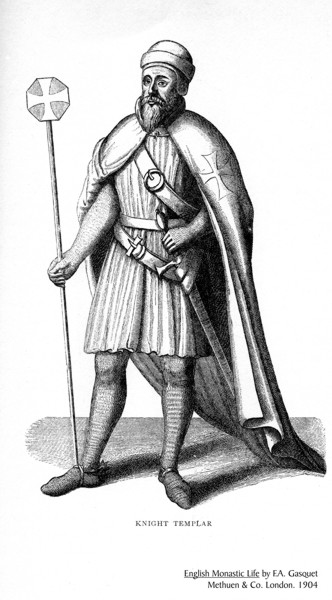
---235---
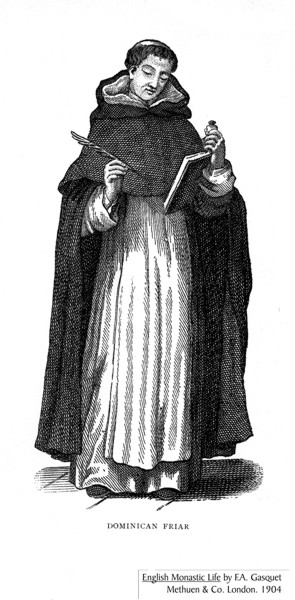
---236---
of Winchester,
in A.D. 1221 and their Order quickly spread. In
the first year of their arrival they obtained a
foothold in the University
of Oxford, and at the time
of the
general suppression of the religious Orders in the Sixteeth century
they had
fifty-eight convents in the country.
ii The Franciscan, or Grey
Friars
St. Francis the
founder of the Grey Friars was contemporary with St. Dominic, and was
born at Assisi,
in the province of Umbria
in Italy,
in
A.D. 1182. These friars were called
Franciscans from their founder ; “Grey Friars” from the colour of their
habit ;
and “Minorites” from their humble desire to be considered the least of
the
Orders. Their rule was approved by
Innocent III in A.D. 1210 and by the General Council of the Lateran in
A.D.
1215. Their dress was made of a course
brown cloth with a long pointed hood of the same material, and a short
cloak.
They girded themselves with a knotted cord and went barefooted. The Franciscan Friars first found their way
to England
in
A.D. 1224, and at the general destruction of Regular life in England
in the sixteenth century they had in all about sixty-six establishments. A reformation of the Order to primitive
observance was made in the fifteenth century and confirmed by the
Council of
Constance in A.D. 1414. The branches of
the Order with adopted it became known as “Observants” or “Recollects.”
This
brand of the Order was represented in England
by several houses built for them by King Henry VII although they are
supposed
to have been brought into England
in the time of Edward IV.
The whole Order
in England
was divided into seven “Custodies” or “Wardenships,” : the houses being
---237---
grouped round
convenient centres
such as London, York,
Cambridge, Bristol,
Oxford, Newcastle,
and Worchester. Harpsfield says that the
“Recollects” or “Observants” had six friaries, at Canterbury,
Greenwich, Richmond,
Southampton, Newark,
and Newcastle.
The Minoresses, or Nuns of St. Clare
The Minoresses
were instituted by St. Clare, the sister of St. Francis of Assisi,
about A.D. 1212, as the branch of the Franciscan Order for females. The followed the Rule of the Friars Minor and
were thus called “Minoresses,” or Nuns of St. Clare, after their
foundress. They wore the same dress as
the Franciscan Friars, and imitated them in their poverty, fro which
cause they
were sometimes known as “Poor Clares.” They
were brought to England
somewhere about A.D. 1293, and established in London,
without Aldgate, in the locality now known as the Minories. The Order had two other houses, one at
Denney, in Cambridgeshire, in which at the time of the general
dissolution
there were some twenty-five nuns ; and
the other at Brusyard in Suffolk,
which was a much smaller establishment. The
nuns at Denney had previously been located at
Waterbeche for about
fifty years, being removed to their new home by Mary, countess of
Pembroke, in
A.D. 1348.
iii. Carmelites
The Carmelite
Friars were so called from the place of their origin.
They were also named “White Friars” from the
colour of the cloak of their habit, and Friars of the Blessed Virgin. These friars are first heard of in the
twelfth century, on being driven out of Palestine
by the persecution of the Saracens. Their
Rule is chiefly founded
---238---
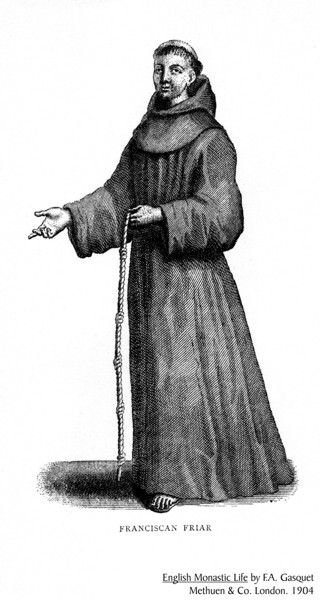
---239---
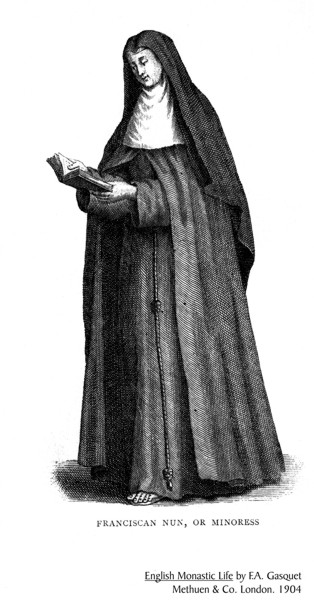
---240---
on that of St.
Basil, and was
confirmed by Pope Honorius III, in A.D. 1224, and finally approved by
Innocent
VI, in 1250. They were brought into England
by John Vesey and Richard Grey, and established their first houses in
the north
at Alnwick, and in the south at Ailesford in Kent. At the latter place the first European
Chapter of the Order was held in A.D. 1245. In
the sixteenth century there were about forty houses in England
and Wales.
iv. Austin Friars, or Hermits
The body of
Austin Friars took
its historical origin in the union of several existing bodies of friars
effected in A.D. 1265 by Pope Clement IV. They
were regarded as belonging to the ranks of the
mendicant friars and
not to the Monastic Order. They were
very widely spread, and in Europe in the
sixteenth
century they are said to have possessed three thousand convents, in
which were
thirty thousand friars ; besides three hundred convents of nuns. In England
at the time of the dissolution they had some thirty-two friaries. 241
V.
The Lesser Friars
i. Friars of the Sack, or De
Penitentia
These brethren
of penance were
called “Friars of the Sack” because there dress was cut without other
form than
that of a simple bag or sack, and made of coarse clothe, like sackcloth. Most authorities, however, represent this as
merely a familiar name, and say that their real title was that of
Friars, or
Brethren of Penance. They took their origin apparently in Italy,
and came to England
during the reign of Henry III., where, about A.D. 1257, they
---241---
opened a house
in London.
They had many settlements in France,
Spain,
and Germany,
but lost most of them after the Council of Lyons in A.D. 1274, when
Pope
Gregory X. suppressed all begging friars with the exception of the four
mendicant Orders of Dominicans, Franciscans, Austin Friars, and
Carmelites. This did not, however, apply
universally, and
in England,
the Fratres de Sacco remained in
existence until the final suppression of the religious Orders in the
sixteenth
century. The dress of these friars was
apparently made of rough brown cloth, and was not unlike that of the
Franciscans ; they had their feet bare and world wooden sandals. Their mode of life was very austere, and they
never ate meat and drank only water.
ii. Pied Friars, or Fratres de
Pica
These religious were so called from the
colours of their habit, which was black and white, like a magpie. They had but one house in England,
at Norwich, and had only a
brief
existence, as the Pied Friars were obliged, by the Council of Lyons, to
join
one or other of the four great mendicant Orders. Their house, which,
according
to Blomfield, stood in the north-east corner of the churchyard of St.
Peter’s
Church, was given to the hospital
of Bek,
at Billingford in Norfolk.
iii. Friars of St. Mary de Areno
There friars had likewise but one house,
at Westminster, founded
towards the
end of the reign of Henry III. They,
too, were short-lived as a body, falling under the law of suppression
of the
lesser mendicant Orders. They, however,
continued
for a few years longer, as Tanner quotes a
---242---
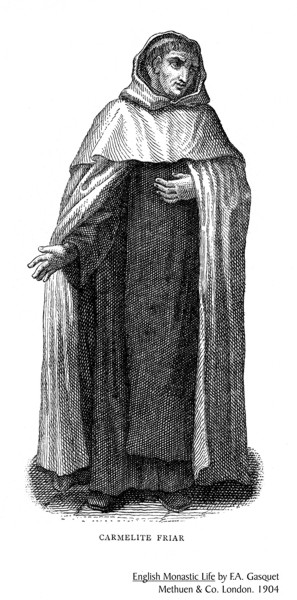 <> <>
---243---
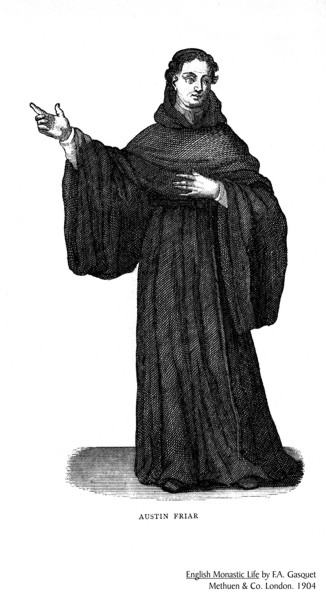
---245---
Close Roll of I I Edward
II., to show that they were only dissolved in that
year, A.D.
1318.
vi. Friars of Our Lady, or de
Domina
The
friars of Our Lady are said to have lived under the Rule of St. Austin. They had a white habit, with a black cloak
and hood. They were instituted in the
thirteenth
century, and had a house at Cambridge,
near the castle. Before A.D. 1290 they
were also settled at Norwich,
where
they continued until the great Pestilence in 1349, of which they all
died.
v. Friars of the holy Trinity,
or Trinitarians
These
religious were founded by SS. John of Matha and Felix of Valois about
A.D. 1197
for the redemption of captives. They
were called “Trinitarians,” because
by their rule all their churches were dedicated to the Holy Trinity, or
“Maturines,” from the fact that their
original foundation in Paris
was
near St. Mathurine’s Chapel. The Order
was confirmed by Pope Innocent III., who gave the religious white
robes, with a
red and blue cross on their breasts, and a cloak with the same emblem
on the
left side. Their revenues were to be
divided into three parts ; one for their own support, one to relieve
the poor,
and the third to ransom Christians who had been taken captive by the
infidels. They were brought to England
in A.D. 1244, and were given the lands and privileges of the Canons of
the Holy
Sepulchre on the extinction of that order. According
to the Monasticon,
they had, in all, eleven houses in this country ; but these
establishments were
small, the usual number of religious in each being three friars and
three lay
brothers. The superior was
---245---
named
‘”minister,” and included
in his office the functions of superior and procurator ; and the houses
were
united into a congregation under a Minister
major, who held a general Chapter annually for the regulation of
defects
and the discussion of common interests.
vi. Crutched, of Crossed Friars
The
Crossed Friars are said by some to have taken their origin in the Low
Countries, by others to have come from Italy in very early times,
having been
instituted or reformed by one Gerard, prior of St. Maria di Morella at
Bologna. In 1169 Pope Alexander III.
took them under his protection and gave them a fixed rule of life. These friars first came to England
in the year 1244. Matthew Paris, writing
of that time, says that they appeared before a synod held by the bishop
of Rochester,
each carrying a stick upon which was a cross. They
presented documents from the pope and asked to be
allowed to make
foundations of their fraternity in England. Clement Reyner put their first establishment
in this country at Reigate, in 1245, and their
second in London in 1249. This last is the better known, as it has
given the name of Crutched Friars to a locality in the city of London. The friars had a third house at Oxford,
and altogether there were six or seven English friaries.
Besides the cross upon their staves, from
which they originally took their name, the friars had a red cloth cross
upon
the breasts of their habits.
vii.
The Bethelmite Friars
The
origin of these friars is uncertain, and they were apparently only
known in England,
and so may perhaps
---264---
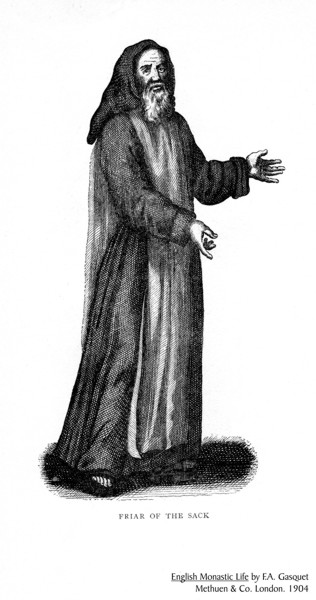
---265---
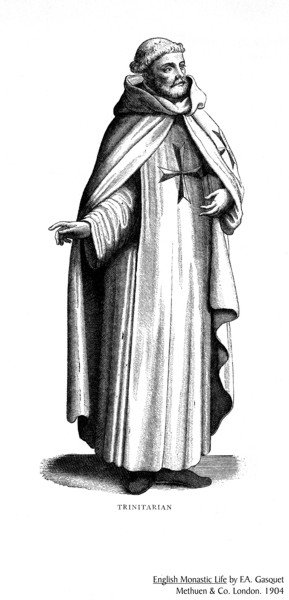
---266---
be considered
to have had their
beginning in this country. Matthew Paris
says that in the year 1257 they were given a house at Cambridge,
in Trumpington Street.
He
describes their dress as being very like that of the Dominicans, from
which it
was distinguished only by having a red star, or five points with a
round blue
centre, on the scapular. This badge
recalled the meaning of their name, representing as it did the star
which led
the Magi to Bethlehem.
viii. The Bonshommes
These friars
were apparently of
English Origin. Some have thought that
they were the same as the “Friars of the Sack,” but this is by no means
clear. Polydore Vergil says that Edmund
of Cornwall, the brother of Henry III., on his return from Germany
in A.D. 1257, built and endowed a fine monastery at Ashridge. This he gave “to a new order of men, never
before known in England,
called Boni Homines, the Bonshommes.
They followed the rule of St.
Augustine, wearing a blue-coloured dress of a
form
similar to that of the Augustinian Hermits.” The
only other house possessed by the Bonshommes was at
Edingdon.
---249---
--end
chapter--
|


 <>
<>